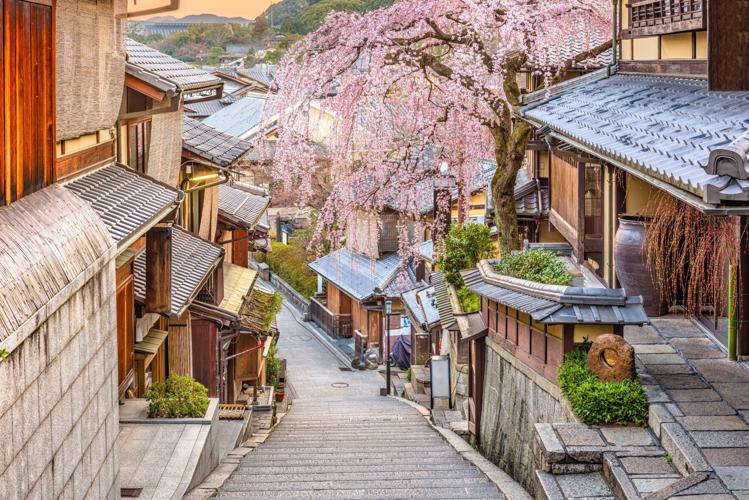I slip down an alley off a quiet Kyoto street and into a boutique that IŌĆÖve identified as a paragon of contemporary Japanese fashion. Inside, the dim lighting and quiet jazz soundtrack emphasize the cool elegance, but as my gaze extends past the silk scarves and structured blazers, it lands on an object of sheer terror: a pair of slippers at the base of a tatami mat.
Frozen in place, I have no idea what to do. I want to gingerly paw the delicate and expensive fabrics, but I donŌĆÖt know the protocol. I think back to what IŌĆÖve been told: no shoes on tatami mats. No luggage or anything heavy. But am I supposed to take off my shoes in a store? Are these slippers for me? How do I get to the hand-dyed cashmere just 10 feet away?
I love Japan. ItŌĆÖs also one of the most rigidly rules-based societies IŌĆÖve ever visited. There are instructions posted everywhere, depicting what to do with your dripping wet umbrella at a storefront (put it in a plastic bag or leave it in an umbrella locker) or how to use a toilet that comes with a remote control (depends on the, uh, situation).
Still, many customs can be utterly opaque to travellers, inspiring the Japan National Tourism Organization to publish a .
As the country grapples with concerns about overtourism ŌĆö a record-breaking 36.9 million international visitors came in 2024 ŌĆö my husband and I spend our trip this March trying to avoid appearing like culturally clueless outsiders.
Fortunately, weŌĆÖre in the capable hands of an expert who can save us from breaching decorum. IŌĆÖm here on an eight-day, rail-based tour with , and grasping Japanese customs is on the itinerary as we travel both popular cities (Tokyo, Kyoto, Osaka) and more remote, pastoral towns (Mishima, Kawane).

Spring blossoms frame Osaka Castle, one of the cityŌĆÖs most recognizable┬Ālandmarks.
Sean Pavone/EnvatoIn addition to having the usual tour benefits (someone else figuring out train tickets and hotel bookings for us), weŌĆÖre led by an earnest and organized guide, Jane, who immediately becomes the one person keeping us from acting like idiots. My husband affectionately ordains her our ŌĆ£rules doula.ŌĆØ
Everywhere we go, Jane pauses, gathers our small group into a huddle so she doesnŌĆÖt have to raise her voice (rude) and explains the local conduct. ThereŌĆÖs a lot of minutiae, and itŌĆÖs often not intuitive.
For example, there are vending machines everywhere, selling a range of things from hot coffee to frozen foods, but itŌĆÖs impolite to eat on the street. ItŌĆÖs also rude to eat or drink on the subway or local trains, but not on the bullet train. Jane introduces us to ekiben, the bento boxes sold in high-speed rail stations across the country.
In Tokyo and Kyoto, itŌĆÖs imperative to stand on the left side of the escalator; in Osaka, itŌĆÖs the right side. And when weŌĆÖre dispatched to overnight homestays in Kawane, located in a pretty tea-growing region with just-burst cherry blossoms, Jane texts the group guidelines for staying in a private home (white people bowing is acceptable; Japanese walls are thin so be mindful of noise).
When we arrive in Kyoto on a grey drizzly day, IŌĆÖm thrilled to discover that our hotel has a semi-public onsen (hot springs bath), and I scrupulously follow JaneŌĆÖs instructions. Onsens are for communal soaking, not cleansing, so itŌĆÖs important to wash first. I silently remove my clothes and take a shower, sitting on the small stool provided and making sure I donŌĆÖt splash anyone else, before easing into the slightly effervescent bath.

Japanese etiquette governs many activities, including how to properly use a hot springs bath.
EyeEm/iStockBut my relaxation gives way to alarm when another woman enters. Though she appears to have showered, she immediately dunks her long hair in the water ŌĆö strictly forbidden.
I sit, paralyzed, torn between the busybody urge to tell her sheŌĆÖs doing it wrong, and concern that she might get me in trouble, as if some onsen enforcer is going to bust through the door (presumably naked and freshly showered, per protocol).
Fortunately, she doesnŌĆÖt stay long. And while I donŌĆÖt report her to the hotel, I do tell Jane, who seems satisfyingly troubled.
At that shop in Kyoto, I eventually discover the tatami protocol the easy way: an Australian woman does it wrong, taking off her shoes (correct) and putting on the slippers (huge mistake).
While she apologizes profusely, her head hung in shame, I tiptoe in my socks over to the very last deep red, luxuriously soft Suzusan cashmere sweater, embarrassing no one. I think Jane would be proud.
Sarah Treleaven travelled as a guest of Intrepid, which did not review or approve this article.

































To join the conversation set a first and last name in your user profile.
Sign in or register for free to join the Conversation